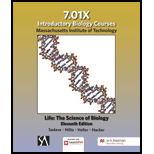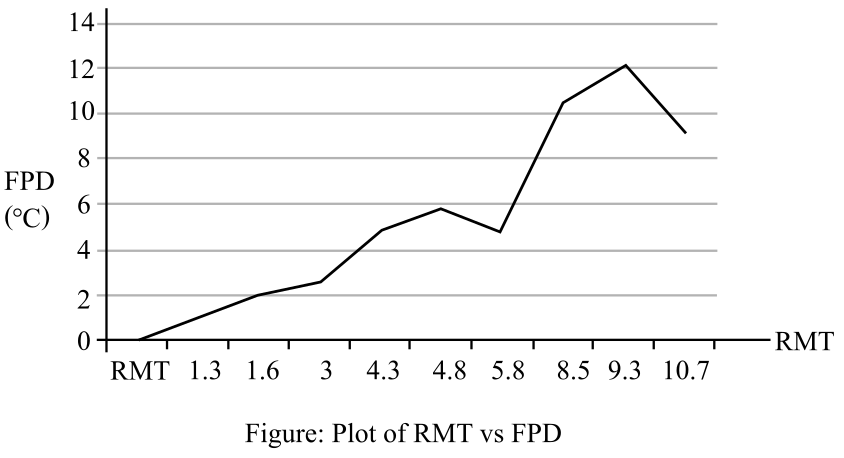
To review:
The relative medullary thickness (RMT) is a good predictor to determine an animal’s ability to produce concentrated urine or not, based on an RMT vs freezing point depression (FPD) plot.
Given:
The RMT and the FPD for different mammals are given in the Table 1:
Table 1: The RMT and FPD of different mammals.
| Animal | RMT | FPD (ᵒC) |
| Beaver | 1.3 | 0.96 |
| Pig | 1.6 | 2 |
| Human | 3 | 2.6 |
| Dog | 4.3 | 4.85 |
| Cat | 4.8 | 5.8 |
| Lab rat | 5.8 | 4.85 |
| Kangaroo rat | 8.5 | 10.4 |
| Jerboa | 9.3 | 12 |
| Sand rat | 10.7 | 9.2 |
Introduction:
RMT refers to the thickness of medulla of the kidney divided by volume (length X width X thickness) of the entire kidney. FPD is a test, which is used to measure the concentration of urine. It is known that fresh water freezes at 0°C, but the addition of solutes lowers this freezing temperature.
Explanation of Solution
The graph plot between RMT and FPD is given in the Figure 1.

Figure 1: Plot of RMT vs FPD.
It can be observed from the graph that as the RMT increases, the FPD also increases. This means that the concentration of the urine increases with an increase in relative length of loops of Henle. The graph follows an almost linearly increasing trend.
A slight deviation from the trend is observed in case of the laboratory rat and the sand rat.
Therefore, it can be concluded that the RMT is a good predictor of the ability of the mammal to produce concentrated urine.
Want to see more full solutions like this?
Chapter 51 Solutions
LIFE:SCIENCE OF BIOL.(LL) >CUSTOM<
- You intend to insert patched dominant negative DNA into the left half of the neural tube of a chick. 1) Which side of the neural tube would you put the positive electrode to ensure that the DNA ends up on the left side? 2) What would be the internal (within the embryo) control for this experiment? 3) How can you be sure that the electroporation method itself is not impacting the embryo? 4) What would you do to ensure that the electroporation is working? How can you tell?arrow_forwardDescribe a method to document the diffusion path and gradient of Sonic Hedgehog through the chicken embryo. If modifying the protein, what is one thing you have to consider in regards to maintaining the protein’s function?arrow_forwardThe following table is from Kumar et. al. Highly Selective Dopamine D3 Receptor (DR) Antagonists and Partial Agonists Based on Eticlopride and the D3R Crystal Structure: New Leads for Opioid Dependence Treatment. J. Med Chem 2016.arrow_forward
- The following figure is from Caterina et al. The capsaicin receptor: a heat activated ion channel in the pain pathway. Nature, 1997. Black boxes indicate capsaicin, white circles indicate resinferatoxin. You are a chef in a fancy new science-themed restaurant. You have a recipe that calls for 1 teaspoon of resinferatoxin, but you feel uncomfortable serving foods with "toxins" in them. How much capsaicin could you substitute instead?arrow_forwardWhat protein is necessary for packaging acetylcholine into synaptic vesicles?arrow_forward1. Match each vocabulary term to its best descriptor A. affinity B. efficacy C. inert D. mimic E. how drugs move through body F. how drugs bind Kd Bmax Agonist Antagonist Pharmacokinetics Pharmacodynamicsarrow_forward
- 50 mg dose of a drug is given orally to a patient. The bioavailability of the drug is 0.2. What is the volume of distribution of the drug if the plasma concentration is 1 mg/L? Be sure to provide units.arrow_forwardDetermine Kd and Bmax from the following Scatchard plot. Make sure to include units.arrow_forwardChoose a catecholamine neurotransmitter and describe/draw the components of the synapse important for its signaling including synthesis, packaging into vesicles, receptors, transporters/degradative enzymes. Describe 2 drugs that can act on this system.arrow_forward
- The following figure is from Caterina et al. The capsaicin receptor: a heat activated ion channel in the pain pathway. Nature, 1997. Black boxes indicate capsaicin, white circles indicate resinferatoxin. a) Which has a higher potency? b) Which is has a higher efficacy? c) What is the approximate Kd of capsaicin in uM? (you can round to the nearest power of 10)arrow_forwardWhat is the rate-limiting-step for serotonin synthesis?arrow_forwardWhat enzyme is necessary for synthesis of all of the monoamines?arrow_forward
 Human Physiology: From Cells to Systems (MindTap ...BiologyISBN:9781285866932Author:Lauralee SherwoodPublisher:Cengage LearningCase Studies In Health Information ManagementBiologyISBN:9781337676908Author:SCHNERINGPublisher:Cengage
Human Physiology: From Cells to Systems (MindTap ...BiologyISBN:9781285866932Author:Lauralee SherwoodPublisher:Cengage LearningCase Studies In Health Information ManagementBiologyISBN:9781337676908Author:SCHNERINGPublisher:Cengage Human Heredity: Principles and Issues (MindTap Co...BiologyISBN:9781305251052Author:Michael CummingsPublisher:Cengage Learning
Human Heredity: Principles and Issues (MindTap Co...BiologyISBN:9781305251052Author:Michael CummingsPublisher:Cengage Learning





